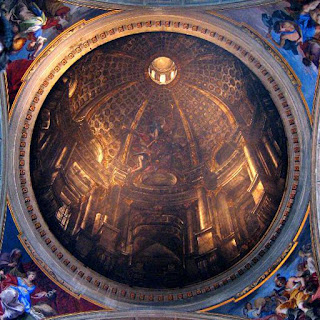VOCABULARY:
a piazza – Italian for plaza or square. Yes, we call it a square even if it’s not shaped like one.
a colonnade – a row of columns.
sacred – holy, of or blessed by God.
to prostrate – to lay down in submission, face down.
anathema – cursed, denounced, often followed by excommunication, or expulsion from the church.
idolatry – worshiping (uctievanie) objects as if they were God.
a baluster - a short column, often used for railings.
a chapel – a small place to pray. It can be a small church, or part of a larger church or cathedral.
a baldachin – a canopy placed over the altar in a cathedral.
a cherub – an angel that looks like a baby.
a missionary – someone who travels to foreign lands to convert pagans to your religion.
a cabal – an illegal organization.
ABOUT THE BAROQUE:
v The Baroque had its political roots in the Catholic Counter Reformation. The church felt threatened by Martin Luther who considered art idolatry, and science to be “that great whore”, as we learned in Gulliver’s Travels. So, the church wanted to promote art that would display their superiority - their virtues, and their power.
v What sets the Baroque apart is its grandeur. The Baroque was about making things big, rich, golden, impressive, and filled with decorations and ornament. Sometimes they went overboard, which is where the Baroque got its name.
v The word ‘baroque’ comes from the Portuguese word ‘barroco’meaning a misshapen pearl. The idea is it’s pretty, but irregular, complicated, and strange. In trying to decorate and enhance beauty , it loses sight of Renaissance aesthetics, commonly considered to be superior.
v Baroque art blurred the lines between painting, sculpture, and architecture, combining them in the creation of churches and chapels, to create a kind of theatre. The idea is you can walk into the artwork, like a 17th century virtual reality.
THE ARTISTS
Bernini, Gian Lorenzo (1598-1680): sculptor, architect, and painter, Bernini is considered the greatest artist of the Baroque, both for his incredible craftsmanship, and for his close relationship and influence with the church in Rome Rome
Ecstacy of St. Teresa, Cornaro Chapel
Apollo & Daphne
Borromini, Francesco (1599-1667): The architect who designed the Church of San Carlo in Rome
Church of San Carlo
Caravaggio (1571-1610): painter who used extreme dark and light to create vivid scenes, like in theatre. You could say that Da Vinci did the same thing, but Caravaggio was more ambitious, creating more and larger paintings, and was more influential to his contemporaries.
Caravaggio’s real name was Michelangelo Merisi, not to be confused with Michelangelo Buonarroti. These are two different artists. Caravaggio has been called unstable, murderous, crazy, and homosexual by historians, but, as with all famous artists and writers of the time, there’s very little evidence to back it up.
The important thing about understanding Caravaggio is that his paintings aren’t just dark because he used black. His goal was to tell the truth no matter how painful, so he painted people as realistically as possible, warts and all. If Caravaggio had to paint an apostle who was an uneducated, illiterate fisherman, he’d paint an angel telling the saint how to write the gospel. This often angered his patrons.
Judith & Holofernes
Carracci, Annibale (1560-1609): painter, especially of ceiling frescos. He painted the ceiling in the palace of Cardinal Farnese
Annibale was a follower of the renaissance painter Raphael, believing that beauty was most important, so that it was okay to idealize your subject. This was counter to Caravaggio, who preferred the, sometimes, ugly truth. This debate sets the tone for all painting from the renaissance up to modern art. All painters from 1600-1900 can be divided into these two sides.
Palaco Farnese ceiling fresco
Pozzo, Andrea (1642-1709): painted the ceiling of the Church of St. Ignazio St. Ignazaio going to heaven.
San Ignazio ceiling fresco
de Ribera, José (Giuseppe, Jusepe) (1591-1652): Spanish painter who came to Rome and then Naples
Corenzio, Belisario (1558-1643): part of the Cabal of Naples
Caracciolo, Giambattista (1578-1635): part of the Cabal of Naples
PLACES:
Trento – Site of the council of Trent Italy , it was then part of Austria







Nice bblog
ReplyDelete